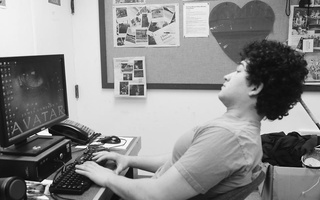
Belle (voiced by Paige O’Hara) looks longingly into the eyes of the Beast (Robby Benson) in Walt Disney Pictures’ newly released 3D version of “Beauty and the Beast.”
For young adults, watching the 1991 version of “Beauty and the Beast” is a highly personal experience, one that alternately elicits nostalgia and increases the anxiety of those who are Disney purists. It is imperative, if only for the sanity of those who grew up glued to the television as Belle tenderly cleaned the Beast’s wound, or as Mrs. Potts nudged Chip into the cupboard, for the movie makers at Walt Disney Pictures to preserve the character and composition of the original “Beauty and the Beast.” Through stereoscopic imaging, the producers manage to preserve the delightful quality of the original 2D film while also enhancing the viewing experience of the new 3D rendition.
The process of converting 2D to 3D stereoscope is not very simple, as it turns out. The characters in the original version were quite flat, and that was part of their charm. Thus, the process chosen to convert charming 2D images into equally charming 3D images had to be stereoscopy. Stereoscopy is a technique of 3D imaging that combines two layered images to provide a sense of depth for the audience. So, rather than having a 3D experience of objects flying out into the audience so that the movie-goers stretch out arms to catch whatever has been virtually hurled at them, stereoscopic 3D movies have a pop-up book appearance. Instead of leaning back in movie seats to avoid splashes of virtual water or bouncing balls, the audience sits on the edge of their seats, wanting to be drawn into the storybook world.
In the prologue of the movie, when an unknown narrator explains the nature of the spell cast on the Beast’s castle, the camera scans through a series of stained glass window displays. The enhancement here is subtle, but one can see that the black lines that outline each figure are slightly imposed upon the swirling colored glass. This rendering gives the realistic appearance of sun shining through actual windows. Then, as a cast of three dozen 3D townspeople sings Belle along the “provincial” streets, it becomes difficult to follow all of the movement taking place. In a single shot of 10 or so characters, there could be as many as 20 layers, with the bread basket, tips of shoes, and cobbled streets each at a different level of depth. It’s a lot for the human brain to process, and for the first few minutes of the movie the experience is slightly nauseating.
However, as the movie progresses, it is possible to forget how many drawings must have been made, how many combinations of perspective were used, and how long this whole conversion must have taken (five years). Instead, the film exudes sheer enjoyment. The characters are the same, the songs are identical though the sound quality has been enhanced, and Belle still has abnormally large eyes and lips, and thin, flesh-colored fingernails. Perhaps the more maudlin parts of the film are revealed upon second viewing—for instance the number of times Belle is literally or metaphorically locked up by a man, or how often she flops onto beds, floors, shoulders, and snow to sob hysterically, or how many weather conditions “Beauty and the Beast” encompasses. For example, it is easy to notice that it is autumn during the frightening forest journey of Belle’s father, that it snows at the castle, that they dance in the famous waltzing-in-the-gold-ballroom scene to the quiet chirping of spring crickets, and that the final fight scene is fought in a summer thunderstorm. But all these more mature observations might be expected—the original audience of “Beauty and the Beast” is older now, more cynical, and more likely to look critically at Disney.
However, it was a comforting experience to return to a fondly remembered favorite. The 3D imagery was tasteful, and the Beast disappointed no one when he finally transformed into all of his long-haired, hunk-of-a-human glory.
—Staff writer Virginia R. Marshall can be reached at virginiarosemarshall@college.harvard.edu.
Read more in Arts
'Tintin' Shows its Age Despite Dream TeamRecommended Articles
-
1905-1906 Lacrosse Game TodayThe second interclass lacrosse game, between the Sophomores and Freshmen, was again prevented yesterday by rain. If the weather allows,
-
THE GRADUATE SCHOOLSAccording to an announcement made yesterday, 18 students, in their third and fourth years at the Harvard Medical School, have
-
 The Limits of Perception
The Limits of Perception -
3D? I’ll Stick With 2Nintendo’s handheld game console, the 3DS, launched in North America this week. Though not the first example of a glasses-free ...
-
3D Overkill3D is not working at the moment. Its expense and lack of visual allure is diminishing the quality of the movie-watching experience in the cinema, and studios need to focus their resources and attention back to improving 2D movies.













